Contract Law: Offer, Acceptance, and Formation of Agreements Analysis
VerifiedAdded on 2023/02/03
|12
|6311
|93
Homework Assignment
AI Summary
This assignment delves into the critical distinction between an offer and an invitation to treat within the realm of contract law. It meticulously examines the legal definitions of both terms, highlighting their practical implications through relevant case law such as Gibson v Manchester City Council and Carlill v Carbolic Smoke Ball Company. The analysis extends to the rules governing acceptance, emphasizing the necessity of communication, the mirror image rule, and the requirement for certainty in agreements. Furthermore, the assignment explores scenarios involving unilateral and bilateral contracts, advertisements, and tenders, providing a comprehensive understanding of contract formation and the factors that determine the enforceability of agreements. The assignment offers a detailed exploration of how courts interpret these concepts, equipping students with a solid foundation in contract law principles.
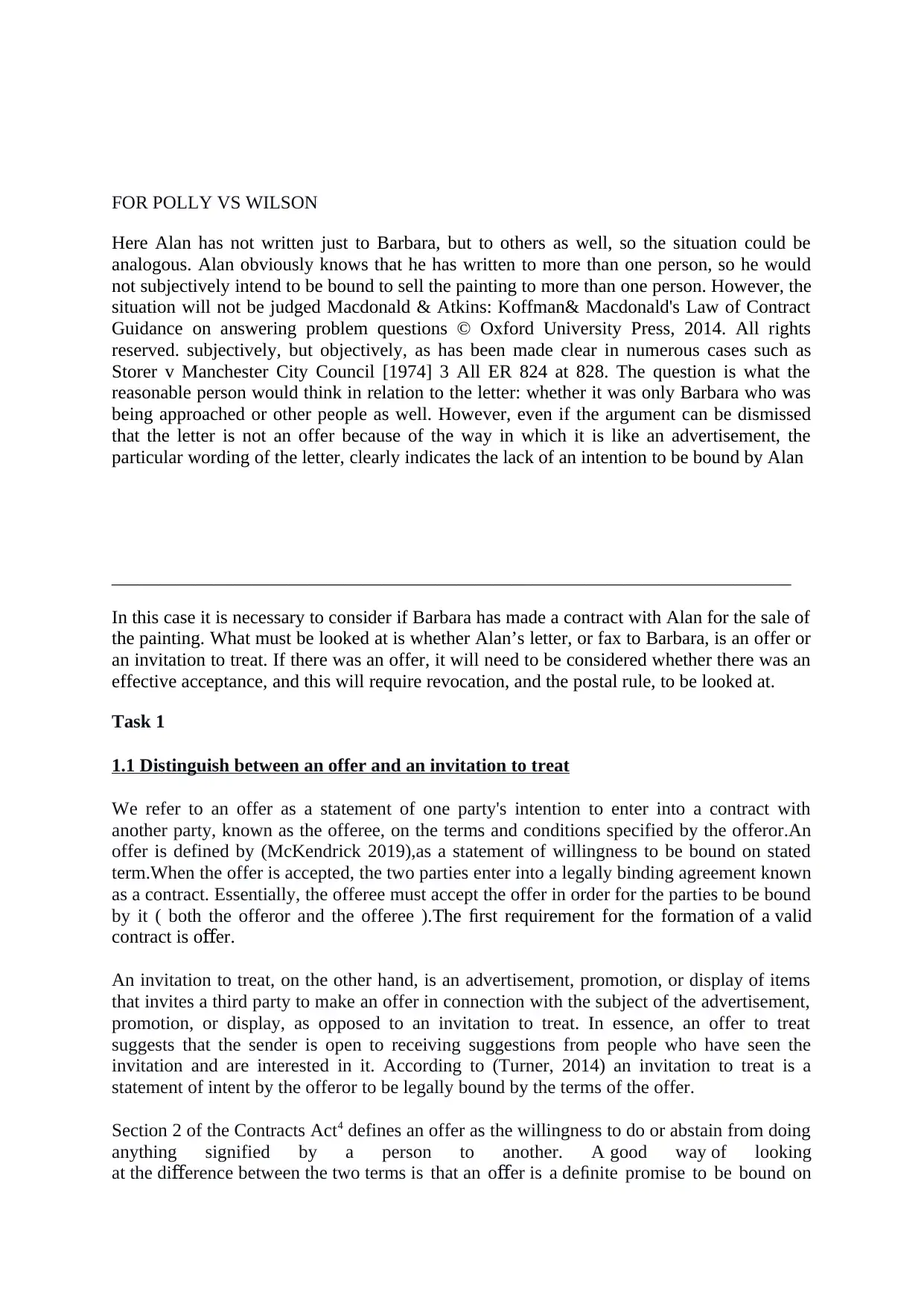
FOR POLLY VS WILSON
Here Alan has not written just to Barbara, but to others as well, so the situation could be
analogous. Alan obviously knows that he has written to more than one person, so he would
not subjectively intend to be bound to sell the painting to more than one person. However, the
situation will not be judged Macdonald & Atkins: Koffman& Macdonald's Law of Contract
Guidance on answering problem questions © Oxford University Press, 2014. All rights
reserved. subjectively, but objectively, as has been made clear in numerous cases such as
Storer v Manchester City Council [1974] 3 All ER 824 at 828. The question is what the
reasonable person would think in relation to the letter: whether it was only Barbara who was
being approached or other people as well. However, even if the argument can be dismissed
that the letter is not an offer because of the way in which it is like an advertisement, the
particular wording of the letter, clearly indicates the lack of an intention to be bound by Alan
_________________________________________________________________________
In this case it is necessary to consider if Barbara has made a contract with Alan for the sale of
the painting. What must be looked at is whether Alan’s letter, or fax to Barbara, is an offer or
an invitation to treat. If there was an offer, it will need to be considered whether there was an
effective acceptance, and this will require revocation, and the postal rule, to be looked at.
Task 1
1.1 Distinguish between an offer and an invitation to treat
We refer to an offer as a statement of one party's intention to enter into a contract with
another party, known as the offeree, on the terms and conditions specified by the offeror.An
offer is defined by (McKendrick 2019),as a statement of willingness to be bound on stated
term.When the offer is accepted, the two parties enter into a legally binding agreement known
as a contract. Essentially, the offeree must accept the offer in order for the parties to be bound
by it ( both the offeror and the offeree ).The first requirement for the formation of a valid
contract is o erff .
An invitation to treat, on the other hand, is an advertisement, promotion, or display of items
that invites a third party to make an offer in connection with the subject of the advertisement,
promotion, or display, as opposed to an invitation to treat. In essence, an offer to treat
suggests that the sender is open to receiving suggestions from people who have seen the
invitation and are interested in it. According to (Turner, 2014) an invitation to treat is a
statement of intent by the offeror to be legally bound by the terms of the offer.
Section 2 of the Contracts Act4 defines an offer as the willingness to do or abstain from doing
anything signified by a person to another. A good way of looking
at the di erenceff between the two terms is that an o erff is a definite promise to be bound on
Here Alan has not written just to Barbara, but to others as well, so the situation could be
analogous. Alan obviously knows that he has written to more than one person, so he would
not subjectively intend to be bound to sell the painting to more than one person. However, the
situation will not be judged Macdonald & Atkins: Koffman& Macdonald's Law of Contract
Guidance on answering problem questions © Oxford University Press, 2014. All rights
reserved. subjectively, but objectively, as has been made clear in numerous cases such as
Storer v Manchester City Council [1974] 3 All ER 824 at 828. The question is what the
reasonable person would think in relation to the letter: whether it was only Barbara who was
being approached or other people as well. However, even if the argument can be dismissed
that the letter is not an offer because of the way in which it is like an advertisement, the
particular wording of the letter, clearly indicates the lack of an intention to be bound by Alan
_________________________________________________________________________
In this case it is necessary to consider if Barbara has made a contract with Alan for the sale of
the painting. What must be looked at is whether Alan’s letter, or fax to Barbara, is an offer or
an invitation to treat. If there was an offer, it will need to be considered whether there was an
effective acceptance, and this will require revocation, and the postal rule, to be looked at.
Task 1
1.1 Distinguish between an offer and an invitation to treat
We refer to an offer as a statement of one party's intention to enter into a contract with
another party, known as the offeree, on the terms and conditions specified by the offeror.An
offer is defined by (McKendrick 2019),as a statement of willingness to be bound on stated
term.When the offer is accepted, the two parties enter into a legally binding agreement known
as a contract. Essentially, the offeree must accept the offer in order for the parties to be bound
by it ( both the offeror and the offeree ).The first requirement for the formation of a valid
contract is o erff .
An invitation to treat, on the other hand, is an advertisement, promotion, or display of items
that invites a third party to make an offer in connection with the subject of the advertisement,
promotion, or display, as opposed to an invitation to treat. In essence, an offer to treat
suggests that the sender is open to receiving suggestions from people who have seen the
invitation and are interested in it. According to (Turner, 2014) an invitation to treat is a
statement of intent by the offeror to be legally bound by the terms of the offer.
Section 2 of the Contracts Act4 defines an offer as the willingness to do or abstain from doing
anything signified by a person to another. A good way of looking
at the di erenceff between the two terms is that an o erff is a definite promise to be bound on
Paraphrase This Document
Need a fresh take? Get an instant paraphrase of this document with our AI Paraphraser
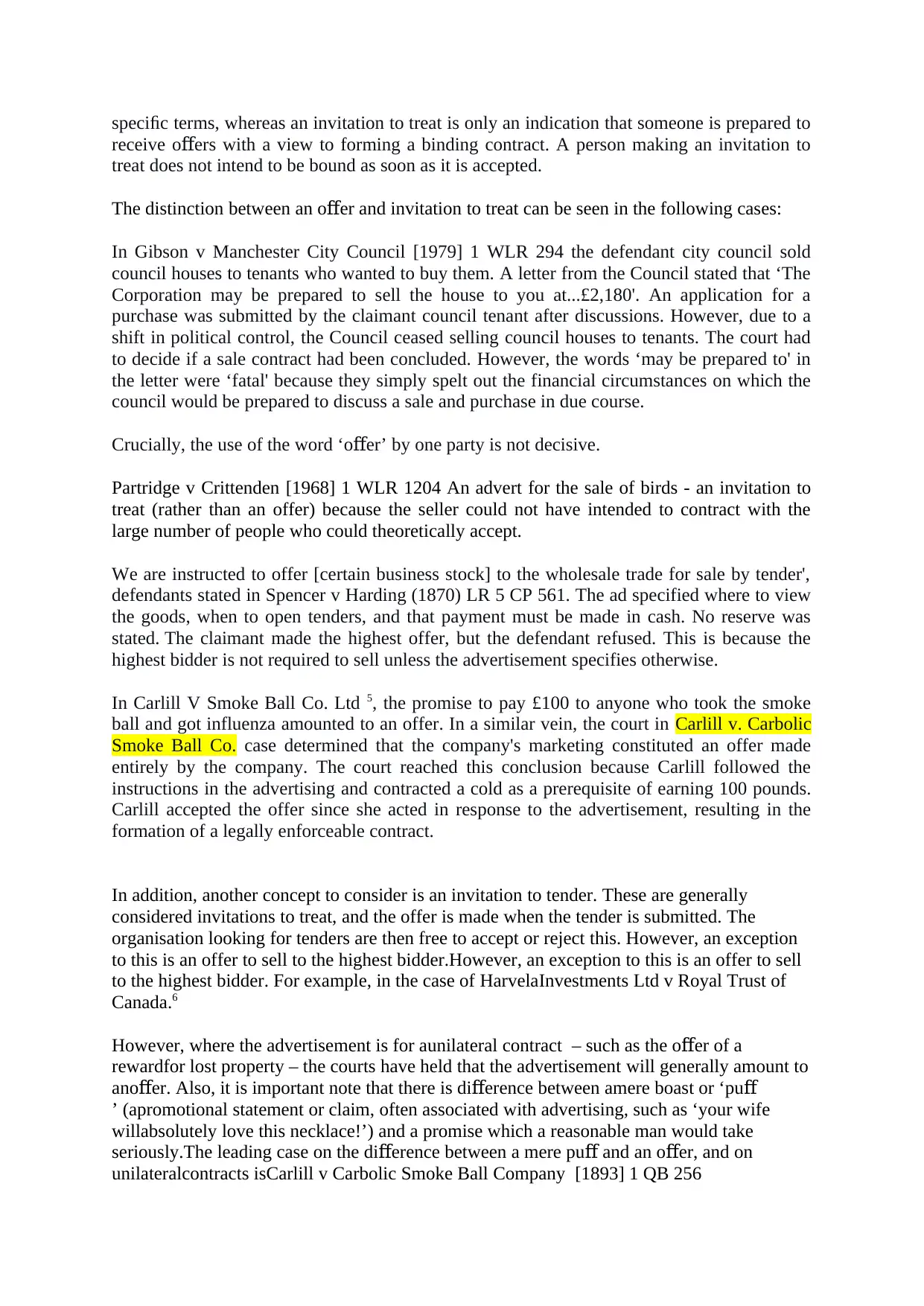
specific terms, whereas an invitation to treat is only an indication that someone is prepared to
receive o ers with a view to forming a binding contract. A person making an invitation toff
treat does not intend to be bound as soon as it is accepted.
The distinction between an o er and invitation to treat can be seen in the following cases:ff
In Gibson v Manchester City Council [1979] 1 WLR 294 the defendant city council sold
council houses to tenants who wanted to buy them. A letter from the Council stated that ‘The
Corporation may be prepared to sell the house to you at...£2,180'. An application for a
purchase was submitted by the claimant council tenant after discussions. However, due to a
shift in political control, the Council ceased selling council houses to tenants. The court had
to decide if a sale contract had been concluded. However, the words ‘may be prepared to' in
the letter were ‘fatal' because they simply spelt out the financial circumstances on which the
council would be prepared to discuss a sale and purchase in due course.
Crucially, the use of the word ‘o er’ by one party is not decisive.ff
Partridge v Crittenden [1968] 1 WLR 1204 An advert for the sale of birds - an invitation to
treat (rather than an offer) because the seller could not have intended to contract with the
large number of people who could theoretically accept.
We are instructed to offer [certain business stock] to the wholesale trade for sale by tender',
defendants stated in Spencer v Harding (1870) LR 5 CP 561. The ad specified where to view
the goods, when to open tenders, and that payment must be made in cash. No reserve was
stated. The claimant made the highest offer, but the defendant refused. This is because the
highest bidder is not required to sell unless the advertisement specifies otherwise.
In Carlill V Smoke Ball Co. Ltd 5, the promise to pay £100 to anyone who took the smoke
ball and got influenza amounted to an offer. In a similar vein, the court in Carlill v. Carbolic
Smoke Ball Co. case determined that the company's marketing constituted an offer made
entirely by the company. The court reached this conclusion because Carlill followed the
instructions in the advertising and contracted a cold as a prerequisite of earning 100 pounds.
Carlill accepted the offer since she acted in response to the advertisement, resulting in the
formation of a legally enforceable contract.
In addition, another concept to consider is an invitation to tender. These are generally
considered invitations to treat, and the offer is made when the tender is submitted. The
organisation looking for tenders are then free to accept or reject this. However, an exception
to this is an offer to sell to the highest bidder.However, an exception to this is an offer to sell
to the highest bidder. For example, in the case of HarvelaInvestments Ltd v Royal Trust of
Canada.6
However, where the advertisement is for aunilateral contract – such as the o er of aff
rewardfor lost property – the courts have held that the advertisement will generally amount to
ano er. Also, it is important note that there is di erence between amere boast or ‘puff ff ff
’ (apromotional statement or claim, often associated with advertising, such as ‘your wife
willabsolutely love this necklace!’) and a promise which a reasonable man would take
seriously.The leading case on the di erence between a mere pu and an o er, and onff ff ff
unilateralcontracts isCarlill v Carbolic Smoke Ball Company [1893] 1 QB 256
receive o ers with a view to forming a binding contract. A person making an invitation toff
treat does not intend to be bound as soon as it is accepted.
The distinction between an o er and invitation to treat can be seen in the following cases:ff
In Gibson v Manchester City Council [1979] 1 WLR 294 the defendant city council sold
council houses to tenants who wanted to buy them. A letter from the Council stated that ‘The
Corporation may be prepared to sell the house to you at...£2,180'. An application for a
purchase was submitted by the claimant council tenant after discussions. However, due to a
shift in political control, the Council ceased selling council houses to tenants. The court had
to decide if a sale contract had been concluded. However, the words ‘may be prepared to' in
the letter were ‘fatal' because they simply spelt out the financial circumstances on which the
council would be prepared to discuss a sale and purchase in due course.
Crucially, the use of the word ‘o er’ by one party is not decisive.ff
Partridge v Crittenden [1968] 1 WLR 1204 An advert for the sale of birds - an invitation to
treat (rather than an offer) because the seller could not have intended to contract with the
large number of people who could theoretically accept.
We are instructed to offer [certain business stock] to the wholesale trade for sale by tender',
defendants stated in Spencer v Harding (1870) LR 5 CP 561. The ad specified where to view
the goods, when to open tenders, and that payment must be made in cash. No reserve was
stated. The claimant made the highest offer, but the defendant refused. This is because the
highest bidder is not required to sell unless the advertisement specifies otherwise.
In Carlill V Smoke Ball Co. Ltd 5, the promise to pay £100 to anyone who took the smoke
ball and got influenza amounted to an offer. In a similar vein, the court in Carlill v. Carbolic
Smoke Ball Co. case determined that the company's marketing constituted an offer made
entirely by the company. The court reached this conclusion because Carlill followed the
instructions in the advertising and contracted a cold as a prerequisite of earning 100 pounds.
Carlill accepted the offer since she acted in response to the advertisement, resulting in the
formation of a legally enforceable contract.
In addition, another concept to consider is an invitation to tender. These are generally
considered invitations to treat, and the offer is made when the tender is submitted. The
organisation looking for tenders are then free to accept or reject this. However, an exception
to this is an offer to sell to the highest bidder.However, an exception to this is an offer to sell
to the highest bidder. For example, in the case of HarvelaInvestments Ltd v Royal Trust of
Canada.6
However, where the advertisement is for aunilateral contract – such as the o er of aff
rewardfor lost property – the courts have held that the advertisement will generally amount to
ano er. Also, it is important note that there is di erence between amere boast or ‘puff ff ff
’ (apromotional statement or claim, often associated with advertising, such as ‘your wife
willabsolutely love this necklace!’) and a promise which a reasonable man would take
seriously.The leading case on the di erence between a mere pu and an o er, and onff ff ff
unilateralcontracts isCarlill v Carbolic Smoke Ball Company [1893] 1 QB 256
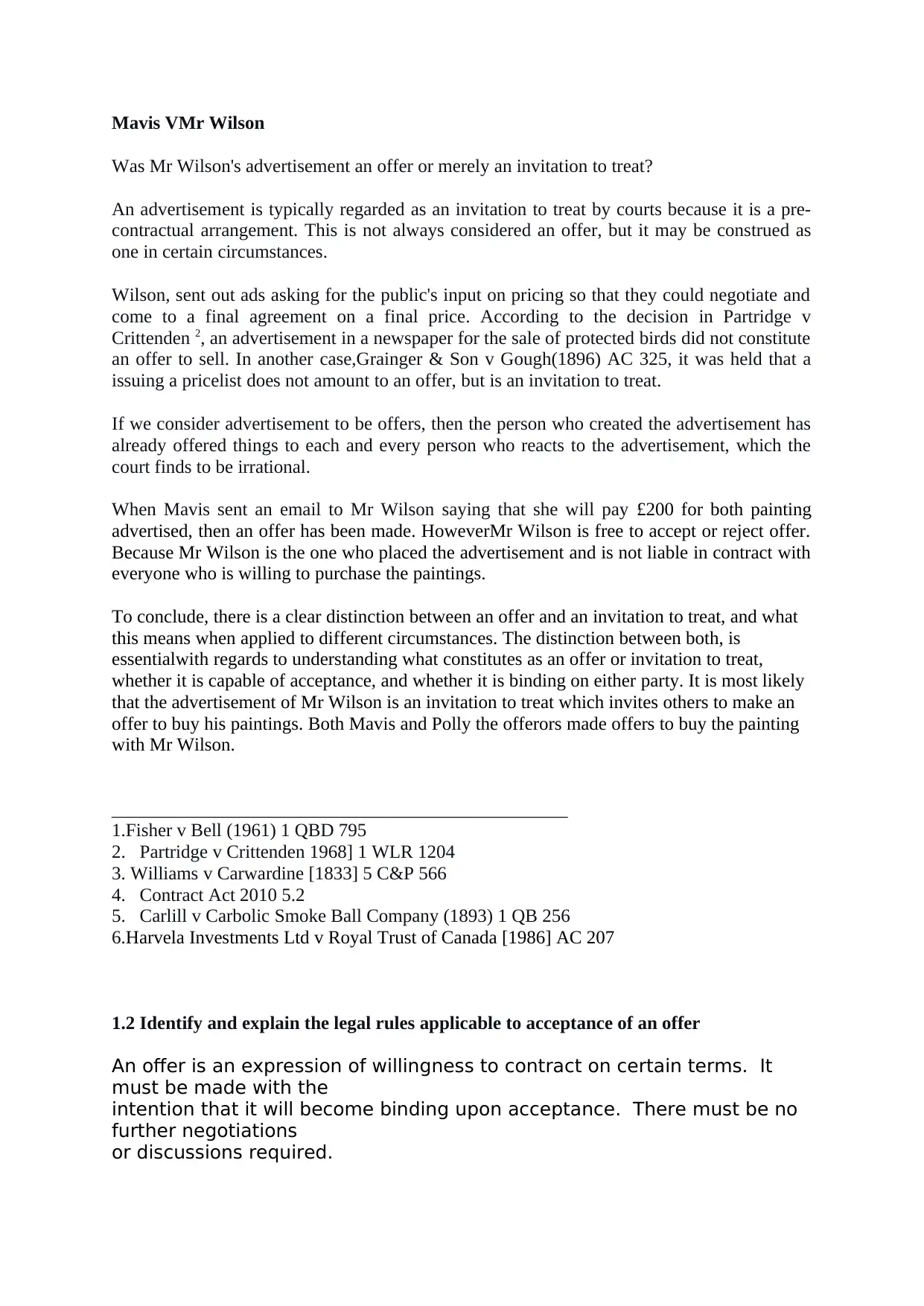
Mavis VMr Wilson
Was Mr Wilson's advertisement an offer or merely an invitation to treat?
An advertisement is typically regarded as an invitation to treat by courts because it is a pre-
contractual arrangement. This is not always considered an offer, but it may be construed as
one in certain circumstances.
Wilson, sent out ads asking for the public's input on pricing so that they could negotiate and
come to a final agreement on a final price. According to the decision in Partridge v
Crittenden 2, an advertisement in a newspaper for the sale of protected birds did not constitute
an offer to sell. In another case,Grainger & Son v Gough(1896) AC 325, it was held that a
issuing a pricelist does not amount to an offer, but is an invitation to treat.
If we consider advertisement to be offers, then the person who created the advertisement has
already offered things to each and every person who reacts to the advertisement, which the
court finds to be irrational.
When Mavis sent an email to Mr Wilson saying that she will pay £200 for both painting
advertised, then an offer has been made. HoweverMr Wilson is free to accept or reject offer.
Because Mr Wilson is the one who placed the advertisement and is not liable in contract with
everyone who is willing to purchase the paintings.
To conclude, there is a clear distinction between an offer and an invitation to treat, and what
this means when applied to different circumstances. The distinction between both, is
essentialwith regards to understanding what constitutes as an offer or invitation to treat,
whether it is capable of acceptance, and whether it is binding on either party. It is most likely
that the advertisement of Mr Wilson is an invitation to treat which invites others to make an
offer to buy his paintings. Both Mavis and Polly the offerors made offers to buy the painting
with Mr Wilson.
_________________________________________________
1.Fisher v Bell (1961) 1 QBD 795
2. Partridge v Crittenden 1968] 1 WLR 1204
3. Williams v Carwardine [1833] 5 C&P 566
4. Contract Act 2010 5.2
5. Carlill v Carbolic Smoke Ball Company (1893) 1 QB 256
6.Harvela Investments Ltd v Royal Trust of Canada [1986] AC 207
1.2 Identify and explain the legal rules applicable to acceptance of an offer
An offer is an expression of willingness to contract on certain terms. It
must be made with the
intention that it will become binding upon acceptance. There must be no
further negotiations
or discussions required.
Was Mr Wilson's advertisement an offer or merely an invitation to treat?
An advertisement is typically regarded as an invitation to treat by courts because it is a pre-
contractual arrangement. This is not always considered an offer, but it may be construed as
one in certain circumstances.
Wilson, sent out ads asking for the public's input on pricing so that they could negotiate and
come to a final agreement on a final price. According to the decision in Partridge v
Crittenden 2, an advertisement in a newspaper for the sale of protected birds did not constitute
an offer to sell. In another case,Grainger & Son v Gough(1896) AC 325, it was held that a
issuing a pricelist does not amount to an offer, but is an invitation to treat.
If we consider advertisement to be offers, then the person who created the advertisement has
already offered things to each and every person who reacts to the advertisement, which the
court finds to be irrational.
When Mavis sent an email to Mr Wilson saying that she will pay £200 for both painting
advertised, then an offer has been made. HoweverMr Wilson is free to accept or reject offer.
Because Mr Wilson is the one who placed the advertisement and is not liable in contract with
everyone who is willing to purchase the paintings.
To conclude, there is a clear distinction between an offer and an invitation to treat, and what
this means when applied to different circumstances. The distinction between both, is
essentialwith regards to understanding what constitutes as an offer or invitation to treat,
whether it is capable of acceptance, and whether it is binding on either party. It is most likely
that the advertisement of Mr Wilson is an invitation to treat which invites others to make an
offer to buy his paintings. Both Mavis and Polly the offerors made offers to buy the painting
with Mr Wilson.
_________________________________________________
1.Fisher v Bell (1961) 1 QBD 795
2. Partridge v Crittenden 1968] 1 WLR 1204
3. Williams v Carwardine [1833] 5 C&P 566
4. Contract Act 2010 5.2
5. Carlill v Carbolic Smoke Ball Company (1893) 1 QB 256
6.Harvela Investments Ltd v Royal Trust of Canada [1986] AC 207
1.2 Identify and explain the legal rules applicable to acceptance of an offer
An offer is an expression of willingness to contract on certain terms. It
must be made with the
intention that it will become binding upon acceptance. There must be no
further negotiations
or discussions required.
⊘ This is a preview!⊘
Do you want full access?
Subscribe today to unlock all pages.

Trusted by 1+ million students worldwide
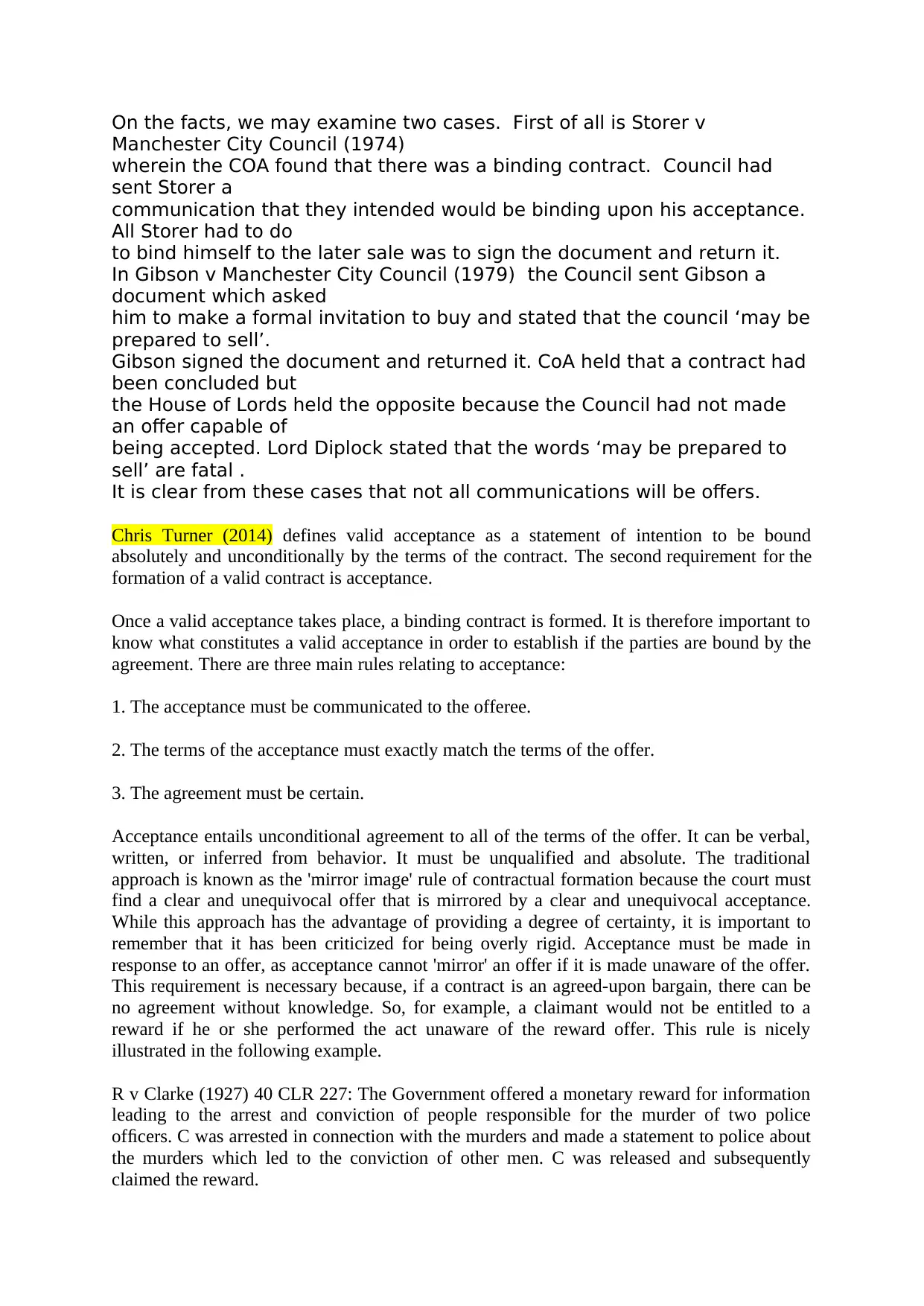
On the facts, we may examine two cases. First of all is Storer v
Manchester City Council (1974)
wherein the COA found that there was a binding contract. Council had
sent Storer a
communication that they intended would be binding upon his acceptance.
All Storer had to do
to bind himself to the later sale was to sign the document and return it.
In Gibson v Manchester City Council (1979) the Council sent Gibson a
document which asked
him to make a formal invitation to buy and stated that the council ‘may be
prepared to sell’.
Gibson signed the document and returned it. CoA held that a contract had
been concluded but
the House of Lords held the opposite because the Council had not made
an offer capable of
being accepted. Lord Diplock stated that the words ‘may be prepared to
sell’ are fatal .
It is clear from these cases that not all communications will be offers.
Chris Turner (2014) defines valid acceptance as a statement of intention to be bound
absolutely and unconditionally by the terms of the contract. The second requirement for the
formation of a valid contract is acceptance.
Once a valid acceptance takes place, a binding contract is formed. It is therefore important to
know what constitutes a valid acceptance in order to establish if the parties are bound by the
agreement. There are three main rules relating to acceptance:
1. The acceptance must be communicated to the offeree.
2. The terms of the acceptance must exactly match the terms of the offer.
3. The agreement must be certain.
Acceptance entails unconditional agreement to all of the terms of the offer. It can be verbal,
written, or inferred from behavior. It must be unqualified and absolute. The traditional
approach is known as the 'mirror image' rule of contractual formation because the court must
find a clear and unequivocal offer that is mirrored by a clear and unequivocal acceptance.
While this approach has the advantage of providing a degree of certainty, it is important to
remember that it has been criticized for being overly rigid. Acceptance must be made in
response to an offer, as acceptance cannot 'mirror' an offer if it is made unaware of the offer.
This requirement is necessary because, if a contract is an agreed-upon bargain, there can be
no agreement without knowledge. So, for example, a claimant would not be entitled to a
reward if he or she performed the act unaware of the reward offer. This rule is nicely
illustrated in the following example.
R v Clarke (1927) 40 CLR 227: The Government offered a monetary reward for information
leading to the arrest and conviction of people responsible for the murder of two police
officers. C was arrested in connection with the murders and made a statement to police about
the murders which led to the conviction of other men. C was released and subsequently
claimed the reward.
Manchester City Council (1974)
wherein the COA found that there was a binding contract. Council had
sent Storer a
communication that they intended would be binding upon his acceptance.
All Storer had to do
to bind himself to the later sale was to sign the document and return it.
In Gibson v Manchester City Council (1979) the Council sent Gibson a
document which asked
him to make a formal invitation to buy and stated that the council ‘may be
prepared to sell’.
Gibson signed the document and returned it. CoA held that a contract had
been concluded but
the House of Lords held the opposite because the Council had not made
an offer capable of
being accepted. Lord Diplock stated that the words ‘may be prepared to
sell’ are fatal .
It is clear from these cases that not all communications will be offers.
Chris Turner (2014) defines valid acceptance as a statement of intention to be bound
absolutely and unconditionally by the terms of the contract. The second requirement for the
formation of a valid contract is acceptance.
Once a valid acceptance takes place, a binding contract is formed. It is therefore important to
know what constitutes a valid acceptance in order to establish if the parties are bound by the
agreement. There are three main rules relating to acceptance:
1. The acceptance must be communicated to the offeree.
2. The terms of the acceptance must exactly match the terms of the offer.
3. The agreement must be certain.
Acceptance entails unconditional agreement to all of the terms of the offer. It can be verbal,
written, or inferred from behavior. It must be unqualified and absolute. The traditional
approach is known as the 'mirror image' rule of contractual formation because the court must
find a clear and unequivocal offer that is mirrored by a clear and unequivocal acceptance.
While this approach has the advantage of providing a degree of certainty, it is important to
remember that it has been criticized for being overly rigid. Acceptance must be made in
response to an offer, as acceptance cannot 'mirror' an offer if it is made unaware of the offer.
This requirement is necessary because, if a contract is an agreed-upon bargain, there can be
no agreement without knowledge. So, for example, a claimant would not be entitled to a
reward if he or she performed the act unaware of the reward offer. This rule is nicely
illustrated in the following example.
R v Clarke (1927) 40 CLR 227: The Government offered a monetary reward for information
leading to the arrest and conviction of people responsible for the murder of two police
officers. C was arrested in connection with the murders and made a statement to police about
the murders which led to the conviction of other men. C was released and subsequently
claimed the reward.
Paraphrase This Document
Need a fresh take? Get an instant paraphrase of this document with our AI Paraphraser
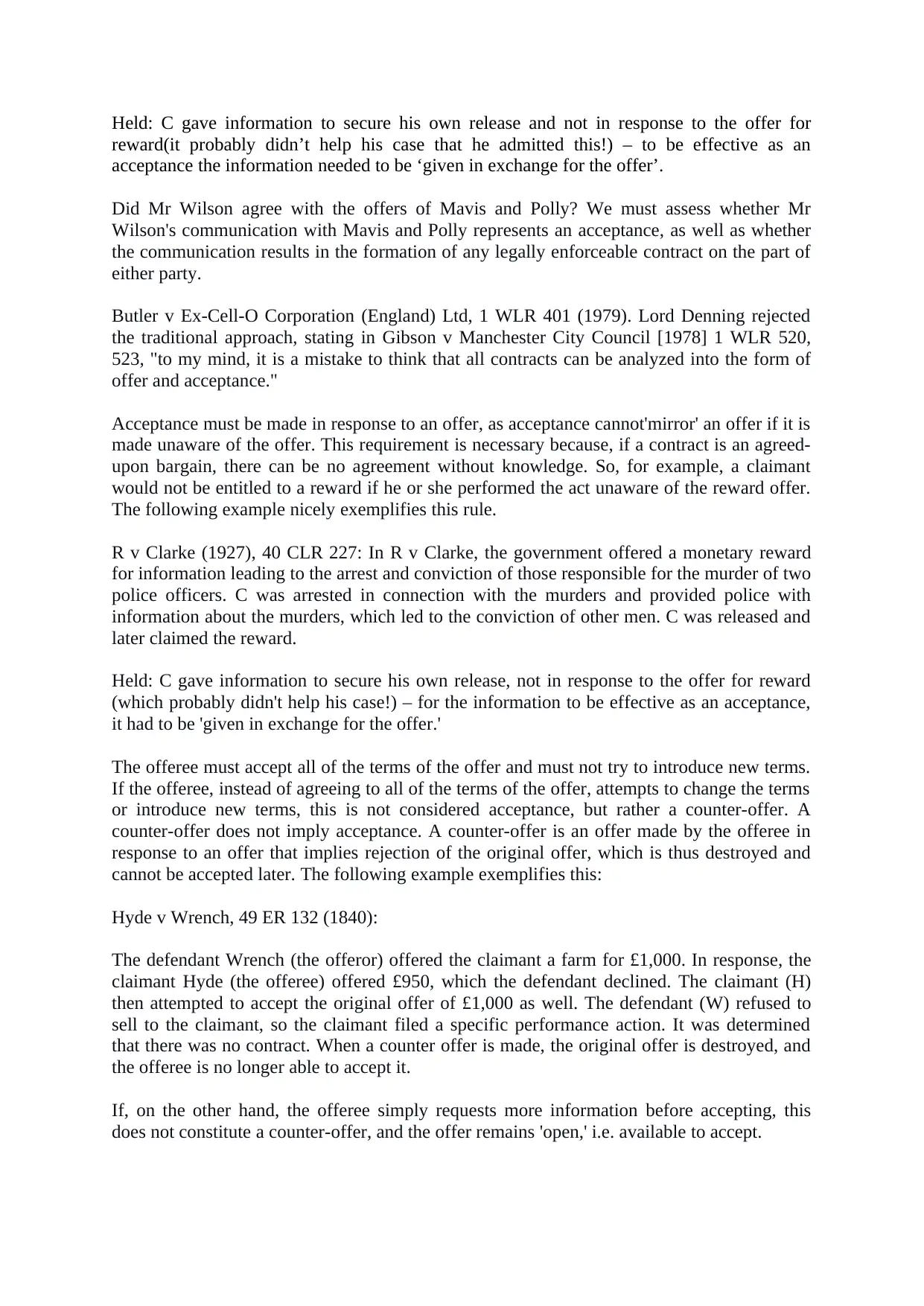
Held: C gave information to secure his own release and not in response to the offer for
reward(it probably didn’t help his case that he admitted this!) – to be effective as an
acceptance the information needed to be ‘given in exchange for the offer’.
Did Mr Wilson agree with the offers of Mavis and Polly? We must assess whether Mr
Wilson's communication with Mavis and Polly represents an acceptance, as well as whether
the communication results in the formation of any legally enforceable contract on the part of
either party.
Butler v Ex-Cell-O Corporation (England) Ltd, 1 WLR 401 (1979). Lord Denning rejected
the traditional approach, stating in Gibson v Manchester City Council [1978] 1 WLR 520,
523, "to my mind, it is a mistake to think that all contracts can be analyzed into the form of
offer and acceptance."
Acceptance must be made in response to an offer, as acceptance cannot'mirror' an offer if it is
made unaware of the offer. This requirement is necessary because, if a contract is an agreed-
upon bargain, there can be no agreement without knowledge. So, for example, a claimant
would not be entitled to a reward if he or she performed the act unaware of the reward offer.
The following example nicely exemplifies this rule.
R v Clarke (1927), 40 CLR 227: In R v Clarke, the government offered a monetary reward
for information leading to the arrest and conviction of those responsible for the murder of two
police officers. C was arrested in connection with the murders and provided police with
information about the murders, which led to the conviction of other men. C was released and
later claimed the reward.
Held: C gave information to secure his own release, not in response to the offer for reward
(which probably didn't help his case!) – for the information to be effective as an acceptance,
it had to be 'given in exchange for the offer.'
The offeree must accept all of the terms of the offer and must not try to introduce new terms.
If the offeree, instead of agreeing to all of the terms of the offer, attempts to change the terms
or introduce new terms, this is not considered acceptance, but rather a counter-offer. A
counter-offer does not imply acceptance. A counter-offer is an offer made by the offeree in
response to an offer that implies rejection of the original offer, which is thus destroyed and
cannot be accepted later. The following example exemplifies this:
Hyde v Wrench, 49 ER 132 (1840):
The defendant Wrench (the offeror) offered the claimant a farm for £1,000. In response, the
claimant Hyde (the offeree) offered £950, which the defendant declined. The claimant (H)
then attempted to accept the original offer of £1,000 as well. The defendant (W) refused to
sell to the claimant, so the claimant filed a specific performance action. It was determined
that there was no contract. When a counter offer is made, the original offer is destroyed, and
the offeree is no longer able to accept it.
If, on the other hand, the offeree simply requests more information before accepting, this
does not constitute a counter-offer, and the offer remains 'open,' i.e. available to accept.
reward(it probably didn’t help his case that he admitted this!) – to be effective as an
acceptance the information needed to be ‘given in exchange for the offer’.
Did Mr Wilson agree with the offers of Mavis and Polly? We must assess whether Mr
Wilson's communication with Mavis and Polly represents an acceptance, as well as whether
the communication results in the formation of any legally enforceable contract on the part of
either party.
Butler v Ex-Cell-O Corporation (England) Ltd, 1 WLR 401 (1979). Lord Denning rejected
the traditional approach, stating in Gibson v Manchester City Council [1978] 1 WLR 520,
523, "to my mind, it is a mistake to think that all contracts can be analyzed into the form of
offer and acceptance."
Acceptance must be made in response to an offer, as acceptance cannot'mirror' an offer if it is
made unaware of the offer. This requirement is necessary because, if a contract is an agreed-
upon bargain, there can be no agreement without knowledge. So, for example, a claimant
would not be entitled to a reward if he or she performed the act unaware of the reward offer.
The following example nicely exemplifies this rule.
R v Clarke (1927), 40 CLR 227: In R v Clarke, the government offered a monetary reward
for information leading to the arrest and conviction of those responsible for the murder of two
police officers. C was arrested in connection with the murders and provided police with
information about the murders, which led to the conviction of other men. C was released and
later claimed the reward.
Held: C gave information to secure his own release, not in response to the offer for reward
(which probably didn't help his case!) – for the information to be effective as an acceptance,
it had to be 'given in exchange for the offer.'
The offeree must accept all of the terms of the offer and must not try to introduce new terms.
If the offeree, instead of agreeing to all of the terms of the offer, attempts to change the terms
or introduce new terms, this is not considered acceptance, but rather a counter-offer. A
counter-offer does not imply acceptance. A counter-offer is an offer made by the offeree in
response to an offer that implies rejection of the original offer, which is thus destroyed and
cannot be accepted later. The following example exemplifies this:
Hyde v Wrench, 49 ER 132 (1840):
The defendant Wrench (the offeror) offered the claimant a farm for £1,000. In response, the
claimant Hyde (the offeree) offered £950, which the defendant declined. The claimant (H)
then attempted to accept the original offer of £1,000 as well. The defendant (W) refused to
sell to the claimant, so the claimant filed a specific performance action. It was determined
that there was no contract. When a counter offer is made, the original offer is destroyed, and
the offeree is no longer able to accept it.
If, on the other hand, the offeree simply requests more information before accepting, this
does not constitute a counter-offer, and the offer remains 'open,' i.e. available to accept.
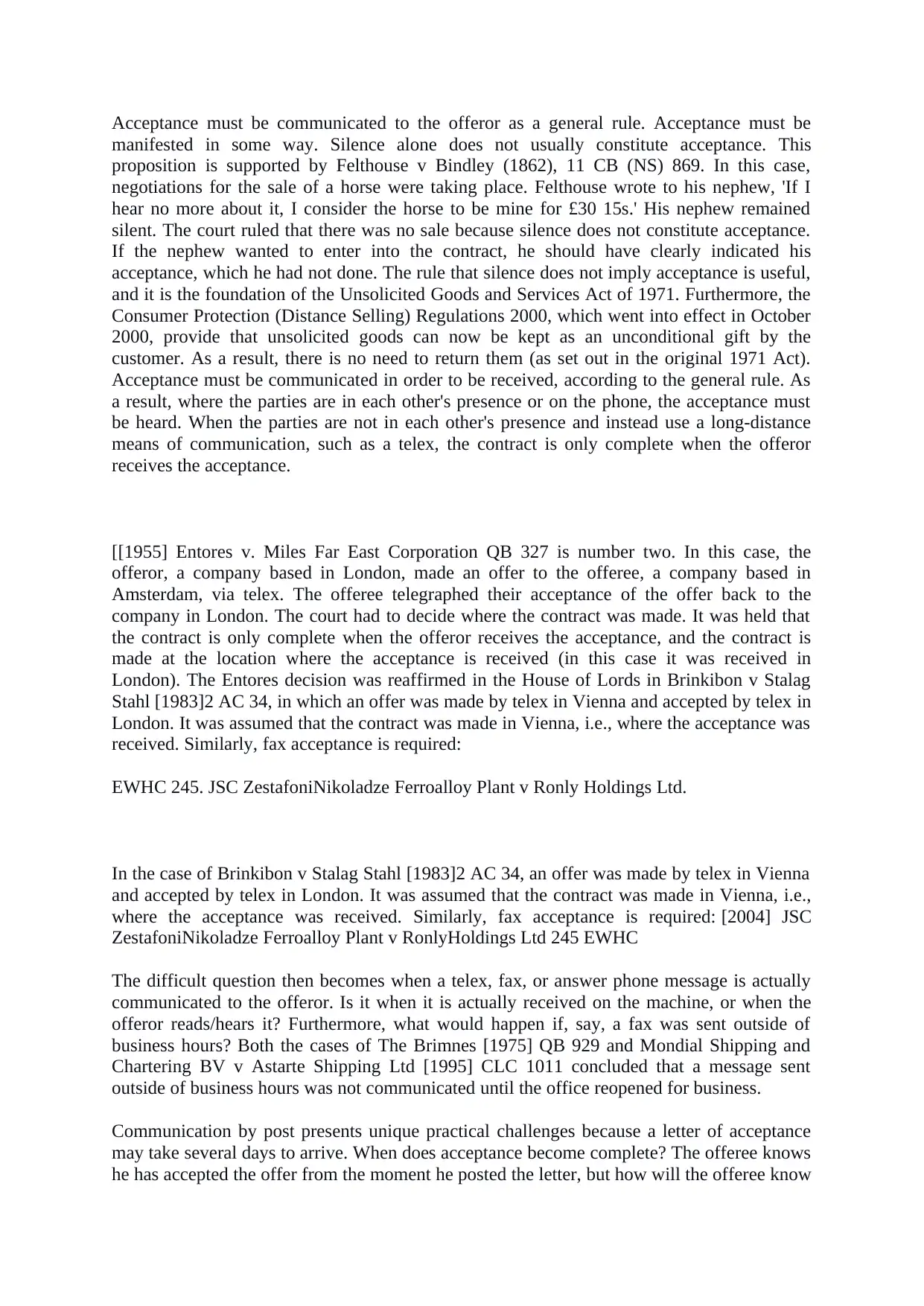
Acceptance must be communicated to the offeror as a general rule. Acceptance must be
manifested in some way. Silence alone does not usually constitute acceptance. This
proposition is supported by Felthouse v Bindley (1862), 11 CB (NS) 869. In this case,
negotiations for the sale of a horse were taking place. Felthouse wrote to his nephew, 'If I
hear no more about it, I consider the horse to be mine for £30 15s.' His nephew remained
silent. The court ruled that there was no sale because silence does not constitute acceptance.
If the nephew wanted to enter into the contract, he should have clearly indicated his
acceptance, which he had not done. The rule that silence does not imply acceptance is useful,
and it is the foundation of the Unsolicited Goods and Services Act of 1971. Furthermore, the
Consumer Protection (Distance Selling) Regulations 2000, which went into effect in October
2000, provide that unsolicited goods can now be kept as an unconditional gift by the
customer. As a result, there is no need to return them (as set out in the original 1971 Act).
Acceptance must be communicated in order to be received, according to the general rule. As
a result, where the parties are in each other's presence or on the phone, the acceptance must
be heard. When the parties are not in each other's presence and instead use a long-distance
means of communication, such as a telex, the contract is only complete when the offeror
receives the acceptance.
[[1955] Entores v. Miles Far East Corporation QB 327 is number two. In this case, the
offeror, a company based in London, made an offer to the offeree, a company based in
Amsterdam, via telex. The offeree telegraphed their acceptance of the offer back to the
company in London. The court had to decide where the contract was made. It was held that
the contract is only complete when the offeror receives the acceptance, and the contract is
made at the location where the acceptance is received (in this case it was received in
London). The Entores decision was reaffirmed in the House of Lords in Brinkibon v Stalag
Stahl [1983]2 AC 34, in which an offer was made by telex in Vienna and accepted by telex in
London. It was assumed that the contract was made in Vienna, i.e., where the acceptance was
received. Similarly, fax acceptance is required:
EWHC 245. JSC ZestafoniNikoladze Ferroalloy Plant v Ronly Holdings Ltd.
In the case of Brinkibon v Stalag Stahl [1983]2 AC 34, an offer was made by telex in Vienna
and accepted by telex in London. It was assumed that the contract was made in Vienna, i.e.,
where the acceptance was received. Similarly, fax acceptance is required: [2004] JSC
ZestafoniNikoladze Ferroalloy Plant v RonlyHoldings Ltd 245 EWHC
The difficult question then becomes when a telex, fax, or answer phone message is actually
communicated to the offeror. Is it when it is actually received on the machine, or when the
offeror reads/hears it? Furthermore, what would happen if, say, a fax was sent outside of
business hours? Both the cases of The Brimnes [1975] QB 929 and Mondial Shipping and
Chartering BV v Astarte Shipping Ltd [1995] CLC 1011 concluded that a message sent
outside of business hours was not communicated until the office reopened for business.
Communication by post presents unique practical challenges because a letter of acceptance
may take several days to arrive. When does acceptance become complete? The offeree knows
he has accepted the offer from the moment he posted the letter, but how will the offeree know
manifested in some way. Silence alone does not usually constitute acceptance. This
proposition is supported by Felthouse v Bindley (1862), 11 CB (NS) 869. In this case,
negotiations for the sale of a horse were taking place. Felthouse wrote to his nephew, 'If I
hear no more about it, I consider the horse to be mine for £30 15s.' His nephew remained
silent. The court ruled that there was no sale because silence does not constitute acceptance.
If the nephew wanted to enter into the contract, he should have clearly indicated his
acceptance, which he had not done. The rule that silence does not imply acceptance is useful,
and it is the foundation of the Unsolicited Goods and Services Act of 1971. Furthermore, the
Consumer Protection (Distance Selling) Regulations 2000, which went into effect in October
2000, provide that unsolicited goods can now be kept as an unconditional gift by the
customer. As a result, there is no need to return them (as set out in the original 1971 Act).
Acceptance must be communicated in order to be received, according to the general rule. As
a result, where the parties are in each other's presence or on the phone, the acceptance must
be heard. When the parties are not in each other's presence and instead use a long-distance
means of communication, such as a telex, the contract is only complete when the offeror
receives the acceptance.
[[1955] Entores v. Miles Far East Corporation QB 327 is number two. In this case, the
offeror, a company based in London, made an offer to the offeree, a company based in
Amsterdam, via telex. The offeree telegraphed their acceptance of the offer back to the
company in London. The court had to decide where the contract was made. It was held that
the contract is only complete when the offeror receives the acceptance, and the contract is
made at the location where the acceptance is received (in this case it was received in
London). The Entores decision was reaffirmed in the House of Lords in Brinkibon v Stalag
Stahl [1983]2 AC 34, in which an offer was made by telex in Vienna and accepted by telex in
London. It was assumed that the contract was made in Vienna, i.e., where the acceptance was
received. Similarly, fax acceptance is required:
EWHC 245. JSC ZestafoniNikoladze Ferroalloy Plant v Ronly Holdings Ltd.
In the case of Brinkibon v Stalag Stahl [1983]2 AC 34, an offer was made by telex in Vienna
and accepted by telex in London. It was assumed that the contract was made in Vienna, i.e.,
where the acceptance was received. Similarly, fax acceptance is required: [2004] JSC
ZestafoniNikoladze Ferroalloy Plant v RonlyHoldings Ltd 245 EWHC
The difficult question then becomes when a telex, fax, or answer phone message is actually
communicated to the offeror. Is it when it is actually received on the machine, or when the
offeror reads/hears it? Furthermore, what would happen if, say, a fax was sent outside of
business hours? Both the cases of The Brimnes [1975] QB 929 and Mondial Shipping and
Chartering BV v Astarte Shipping Ltd [1995] CLC 1011 concluded that a message sent
outside of business hours was not communicated until the office reopened for business.
Communication by post presents unique practical challenges because a letter of acceptance
may take several days to arrive. When does acceptance become complete? The offeree knows
he has accepted the offer from the moment he posted the letter, but how will the offeree know
⊘ This is a preview!⊘
Do you want full access?
Subscribe today to unlock all pages.

Trusted by 1+ million students worldwide
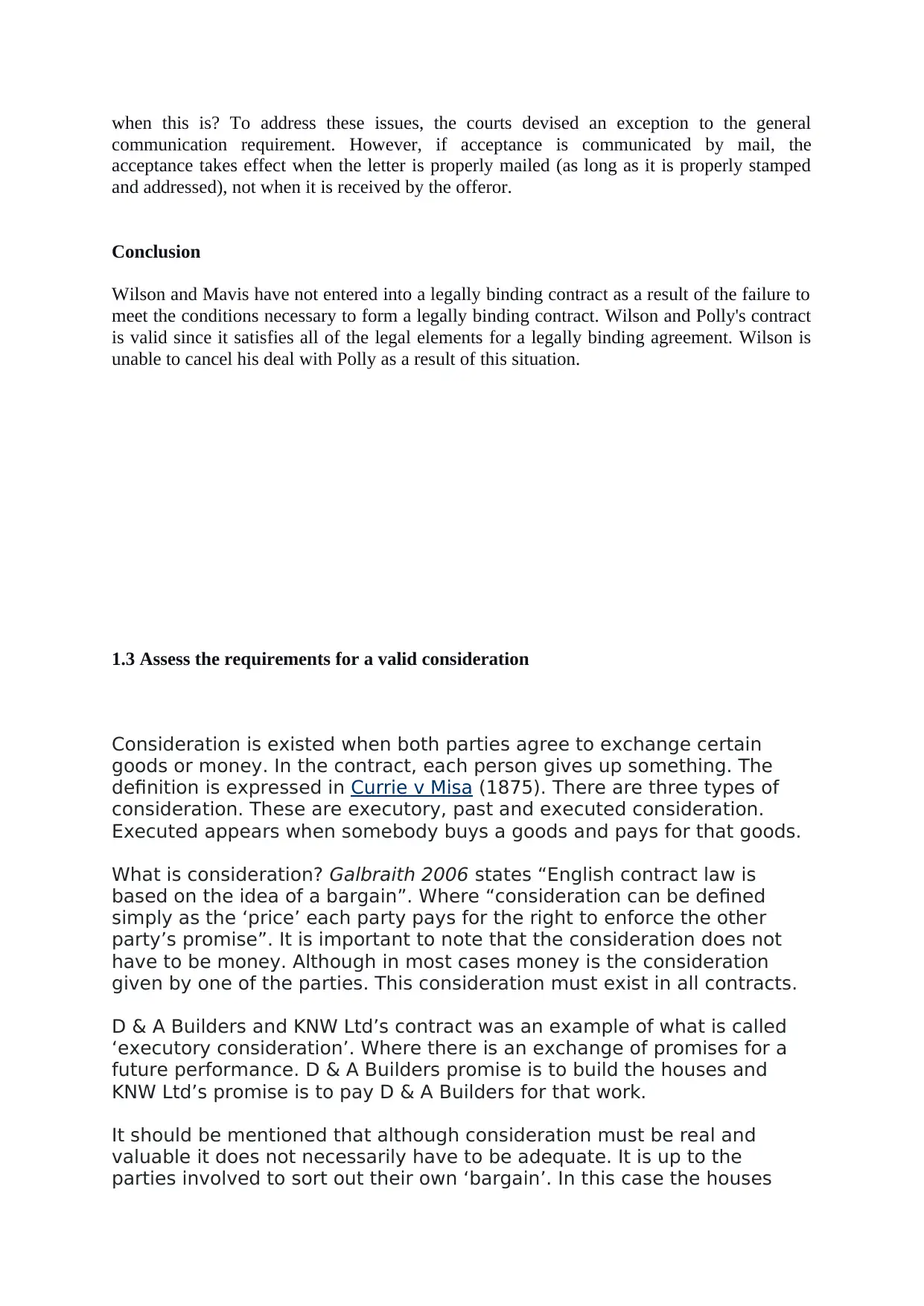
when this is? To address these issues, the courts devised an exception to the general
communication requirement. However, if acceptance is communicated by mail, the
acceptance takes effect when the letter is properly mailed (as long as it is properly stamped
and addressed), not when it is received by the offeror.
Conclusion
Wilson and Mavis have not entered into a legally binding contract as a result of the failure to
meet the conditions necessary to form a legally binding contract. Wilson and Polly's contract
is valid since it satisfies all of the legal elements for a legally binding agreement. Wilson is
unable to cancel his deal with Polly as a result of this situation.
1.3 Assess the requirements for a valid consideration
Consideration is existed when both parties agree to exchange certain
goods or money. In the contract, each person gives up something. The
definition is expressed in Currie v Misa (1875). There are three types of
consideration. These are executory, past and executed consideration.
Executed appears when somebody buys a goods and pays for that goods.
What is consideration? Galbraith 2006 states “English contract law is
based on the idea of a bargain”. Where “consideration can be defined
simply as the ‘price’ each party pays for the right to enforce the other
party’s promise”. It is important to note that the consideration does not
have to be money. Although in most cases money is the consideration
given by one of the parties. This consideration must exist in all contracts.
D & A Builders and KNW Ltd’s contract was an example of what is called
‘executory consideration’. Where there is an exchange of promises for a
future performance. D & A Builders promise is to build the houses and
KNW Ltd’s promise is to pay D & A Builders for that work.
It should be mentioned that although consideration must be real and
valuable it does not necessarily have to be adequate. It is up to the
parties involved to sort out their own ‘bargain’. In this case the houses
communication requirement. However, if acceptance is communicated by mail, the
acceptance takes effect when the letter is properly mailed (as long as it is properly stamped
and addressed), not when it is received by the offeror.
Conclusion
Wilson and Mavis have not entered into a legally binding contract as a result of the failure to
meet the conditions necessary to form a legally binding contract. Wilson and Polly's contract
is valid since it satisfies all of the legal elements for a legally binding agreement. Wilson is
unable to cancel his deal with Polly as a result of this situation.
1.3 Assess the requirements for a valid consideration
Consideration is existed when both parties agree to exchange certain
goods or money. In the contract, each person gives up something. The
definition is expressed in Currie v Misa (1875). There are three types of
consideration. These are executory, past and executed consideration.
Executed appears when somebody buys a goods and pays for that goods.
What is consideration? Galbraith 2006 states “English contract law is
based on the idea of a bargain”. Where “consideration can be defined
simply as the ‘price’ each party pays for the right to enforce the other
party’s promise”. It is important to note that the consideration does not
have to be money. Although in most cases money is the consideration
given by one of the parties. This consideration must exist in all contracts.
D & A Builders and KNW Ltd’s contract was an example of what is called
‘executory consideration’. Where there is an exchange of promises for a
future performance. D & A Builders promise is to build the houses and
KNW Ltd’s promise is to pay D & A Builders for that work.
It should be mentioned that although consideration must be real and
valuable it does not necessarily have to be adequate. It is up to the
parties involved to sort out their own ‘bargain’. In this case the houses
Paraphrase This Document
Need a fresh take? Get an instant paraphrase of this document with our AI Paraphraser
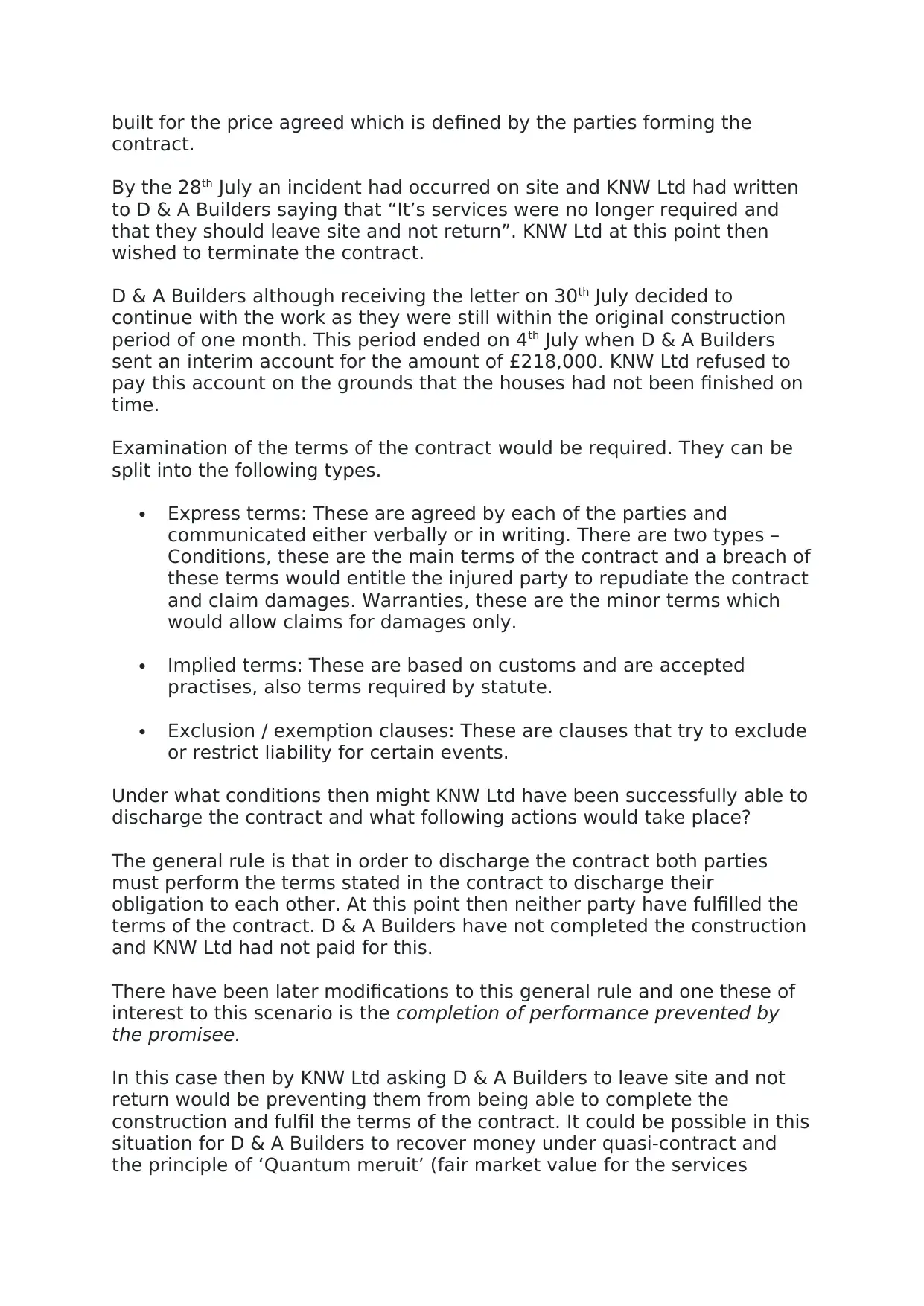
built for the price agreed which is defined by the parties forming the
contract.
By the 28th July an incident had occurred on site and KNW Ltd had written
to D & A Builders saying that “It’s services were no longer required and
that they should leave site and not return”. KNW Ltd at this point then
wished to terminate the contract.
D & A Builders although receiving the letter on 30th July decided to
continue with the work as they were still within the original construction
period of one month. This period ended on 4th July when D & A Builders
sent an interim account for the amount of £218,000. KNW Ltd refused to
pay this account on the grounds that the houses had not been finished on
time.
Examination of the terms of the contract would be required. They can be
split into the following types.
Express terms: These are agreed by each of the parties and
communicated either verbally or in writing. There are two types –
Conditions, these are the main terms of the contract and a breach of
these terms would entitle the injured party to repudiate the contract
and claim damages. Warranties, these are the minor terms which
would allow claims for damages only.
Implied terms: These are based on customs and are accepted
practises, also terms required by statute.
Exclusion / exemption clauses: These are clauses that try to exclude
or restrict liability for certain events.
Under what conditions then might KNW Ltd have been successfully able to
discharge the contract and what following actions would take place?
The general rule is that in order to discharge the contract both parties
must perform the terms stated in the contract to discharge their
obligation to each other. At this point then neither party have fulfilled the
terms of the contract. D & A Builders have not completed the construction
and KNW Ltd had not paid for this.
There have been later modifications to this general rule and one these of
interest to this scenario is the completion of performance prevented by
the promisee.
In this case then by KNW Ltd asking D & A Builders to leave site and not
return would be preventing them from being able to complete the
construction and fulfil the terms of the contract. It could be possible in this
situation for D & A Builders to recover money under quasi-contract and
the principle of ‘Quantum meruit’ (fair market value for the services
contract.
By the 28th July an incident had occurred on site and KNW Ltd had written
to D & A Builders saying that “It’s services were no longer required and
that they should leave site and not return”. KNW Ltd at this point then
wished to terminate the contract.
D & A Builders although receiving the letter on 30th July decided to
continue with the work as they were still within the original construction
period of one month. This period ended on 4th July when D & A Builders
sent an interim account for the amount of £218,000. KNW Ltd refused to
pay this account on the grounds that the houses had not been finished on
time.
Examination of the terms of the contract would be required. They can be
split into the following types.
Express terms: These are agreed by each of the parties and
communicated either verbally or in writing. There are two types –
Conditions, these are the main terms of the contract and a breach of
these terms would entitle the injured party to repudiate the contract
and claim damages. Warranties, these are the minor terms which
would allow claims for damages only.
Implied terms: These are based on customs and are accepted
practises, also terms required by statute.
Exclusion / exemption clauses: These are clauses that try to exclude
or restrict liability for certain events.
Under what conditions then might KNW Ltd have been successfully able to
discharge the contract and what following actions would take place?
The general rule is that in order to discharge the contract both parties
must perform the terms stated in the contract to discharge their
obligation to each other. At this point then neither party have fulfilled the
terms of the contract. D & A Builders have not completed the construction
and KNW Ltd had not paid for this.
There have been later modifications to this general rule and one these of
interest to this scenario is the completion of performance prevented by
the promisee.
In this case then by KNW Ltd asking D & A Builders to leave site and not
return would be preventing them from being able to complete the
construction and fulfil the terms of the contract. It could be possible in this
situation for D & A Builders to recover money under quasi-contract and
the principle of ‘Quantum meruit’ (fair market value for the services
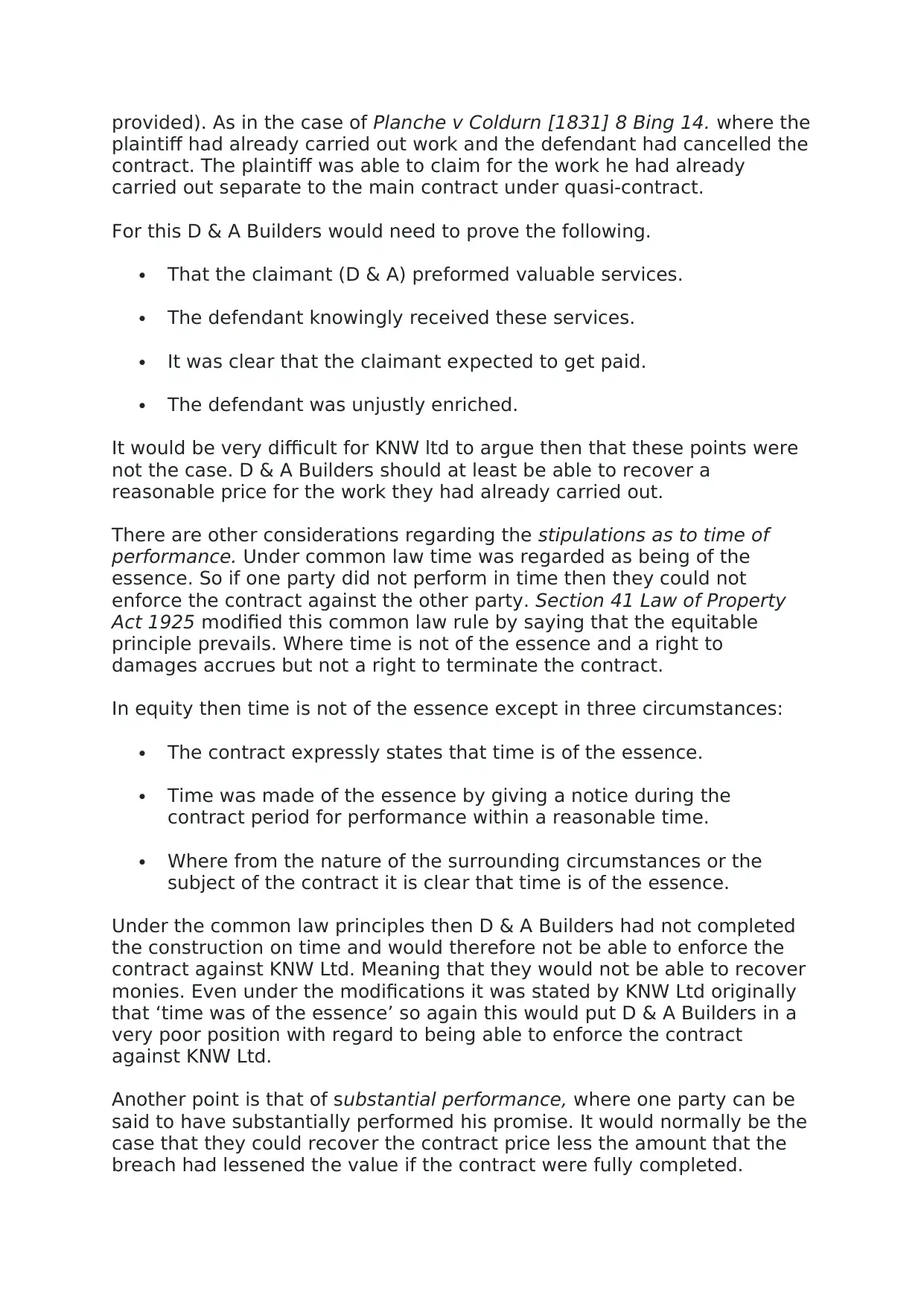
provided). As in the case of Planche v Coldurn [1831] 8 Bing 14. where the
plaintiff had already carried out work and the defendant had cancelled the
contract. The plaintiff was able to claim for the work he had already
carried out separate to the main contract under quasi-contract.
For this D & A Builders would need to prove the following.
That the claimant (D & A) preformed valuable services.
The defendant knowingly received these services.
It was clear that the claimant expected to get paid.
The defendant was unjustly enriched.
It would be very difficult for KNW ltd to argue then that these points were
not the case. D & A Builders should at least be able to recover a
reasonable price for the work they had already carried out.
There are other considerations regarding the stipulations as to time of
performance. Under common law time was regarded as being of the
essence. So if one party did not perform in time then they could not
enforce the contract against the other party. Section 41 Law of Property
Act 1925 modified this common law rule by saying that the equitable
principle prevails. Where time is not of the essence and a right to
damages accrues but not a right to terminate the contract.
In equity then time is not of the essence except in three circumstances:
The contract expressly states that time is of the essence.
Time was made of the essence by giving a notice during the
contract period for performance within a reasonable time.
Where from the nature of the surrounding circumstances or the
subject of the contract it is clear that time is of the essence.
Under the common law principles then D & A Builders had not completed
the construction on time and would therefore not be able to enforce the
contract against KNW Ltd. Meaning that they would not be able to recover
monies. Even under the modifications it was stated by KNW Ltd originally
that ‘time was of the essence’ so again this would put D & A Builders in a
very poor position with regard to being able to enforce the contract
against KNW Ltd.
Another point is that of substantial performance, where one party can be
said to have substantially performed his promise. It would normally be the
case that they could recover the contract price less the amount that the
breach had lessened the value if the contract were fully completed.
plaintiff had already carried out work and the defendant had cancelled the
contract. The plaintiff was able to claim for the work he had already
carried out separate to the main contract under quasi-contract.
For this D & A Builders would need to prove the following.
That the claimant (D & A) preformed valuable services.
The defendant knowingly received these services.
It was clear that the claimant expected to get paid.
The defendant was unjustly enriched.
It would be very difficult for KNW ltd to argue then that these points were
not the case. D & A Builders should at least be able to recover a
reasonable price for the work they had already carried out.
There are other considerations regarding the stipulations as to time of
performance. Under common law time was regarded as being of the
essence. So if one party did not perform in time then they could not
enforce the contract against the other party. Section 41 Law of Property
Act 1925 modified this common law rule by saying that the equitable
principle prevails. Where time is not of the essence and a right to
damages accrues but not a right to terminate the contract.
In equity then time is not of the essence except in three circumstances:
The contract expressly states that time is of the essence.
Time was made of the essence by giving a notice during the
contract period for performance within a reasonable time.
Where from the nature of the surrounding circumstances or the
subject of the contract it is clear that time is of the essence.
Under the common law principles then D & A Builders had not completed
the construction on time and would therefore not be able to enforce the
contract against KNW Ltd. Meaning that they would not be able to recover
monies. Even under the modifications it was stated by KNW Ltd originally
that ‘time was of the essence’ so again this would put D & A Builders in a
very poor position with regard to being able to enforce the contract
against KNW Ltd.
Another point is that of substantial performance, where one party can be
said to have substantially performed his promise. It would normally be the
case that they could recover the contract price less the amount that the
breach had lessened the value if the contract were fully completed.
⊘ This is a preview!⊘
Do you want full access?
Subscribe today to unlock all pages.

Trusted by 1+ million students worldwide
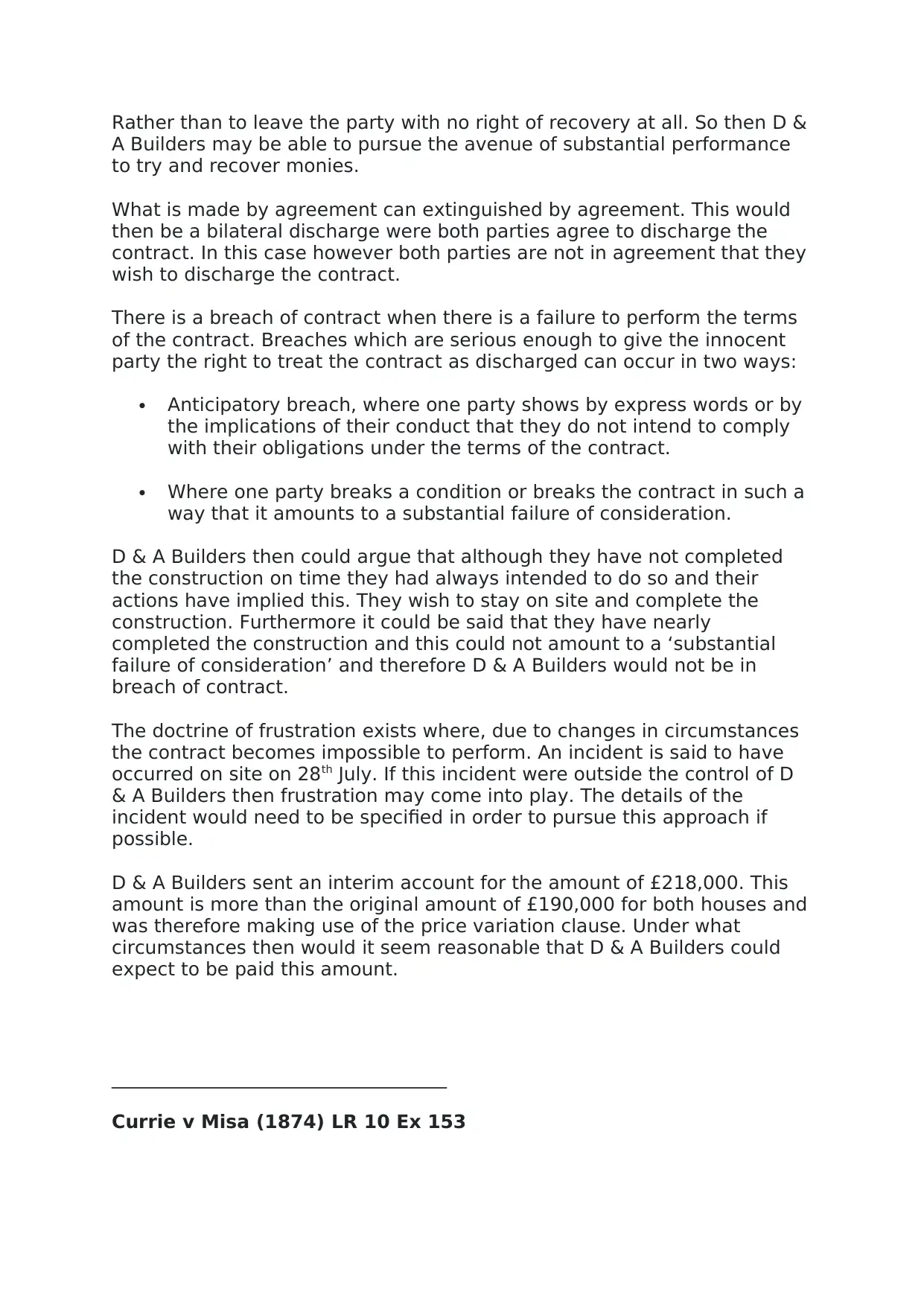
Rather than to leave the party with no right of recovery at all. So then D &
A Builders may be able to pursue the avenue of substantial performance
to try and recover monies.
What is made by agreement can extinguished by agreement. This would
then be a bilateral discharge were both parties agree to discharge the
contract. In this case however both parties are not in agreement that they
wish to discharge the contract.
There is a breach of contract when there is a failure to perform the terms
of the contract. Breaches which are serious enough to give the innocent
party the right to treat the contract as discharged can occur in two ways:
Anticipatory breach, where one party shows by express words or by
the implications of their conduct that they do not intend to comply
with their obligations under the terms of the contract.
Where one party breaks a condition or breaks the contract in such a
way that it amounts to a substantial failure of consideration.
D & A Builders then could argue that although they have not completed
the construction on time they had always intended to do so and their
actions have implied this. They wish to stay on site and complete the
construction. Furthermore it could be said that they have nearly
completed the construction and this could not amount to a ‘substantial
failure of consideration’ and therefore D & A Builders would not be in
breach of contract.
The doctrine of frustration exists where, due to changes in circumstances
the contract becomes impossible to perform. An incident is said to have
occurred on site on 28th July. If this incident were outside the control of D
& A Builders then frustration may come into play. The details of the
incident would need to be specified in order to pursue this approach if
possible.
D & A Builders sent an interim account for the amount of £218,000. This
amount is more than the original amount of £190,000 for both houses and
was therefore making use of the price variation clause. Under what
circumstances then would it seem reasonable that D & A Builders could
expect to be paid this amount.
____________________________________
Currie v Misa (1874) LR 10 Ex 153
A Builders may be able to pursue the avenue of substantial performance
to try and recover monies.
What is made by agreement can extinguished by agreement. This would
then be a bilateral discharge were both parties agree to discharge the
contract. In this case however both parties are not in agreement that they
wish to discharge the contract.
There is a breach of contract when there is a failure to perform the terms
of the contract. Breaches which are serious enough to give the innocent
party the right to treat the contract as discharged can occur in two ways:
Anticipatory breach, where one party shows by express words or by
the implications of their conduct that they do not intend to comply
with their obligations under the terms of the contract.
Where one party breaks a condition or breaks the contract in such a
way that it amounts to a substantial failure of consideration.
D & A Builders then could argue that although they have not completed
the construction on time they had always intended to do so and their
actions have implied this. They wish to stay on site and complete the
construction. Furthermore it could be said that they have nearly
completed the construction and this could not amount to a ‘substantial
failure of consideration’ and therefore D & A Builders would not be in
breach of contract.
The doctrine of frustration exists where, due to changes in circumstances
the contract becomes impossible to perform. An incident is said to have
occurred on site on 28th July. If this incident were outside the control of D
& A Builders then frustration may come into play. The details of the
incident would need to be specified in order to pursue this approach if
possible.
D & A Builders sent an interim account for the amount of £218,000. This
amount is more than the original amount of £190,000 for both houses and
was therefore making use of the price variation clause. Under what
circumstances then would it seem reasonable that D & A Builders could
expect to be paid this amount.
____________________________________
Currie v Misa (1874) LR 10 Ex 153
Paraphrase This Document
Need a fresh take? Get an instant paraphrase of this document with our AI Paraphraser
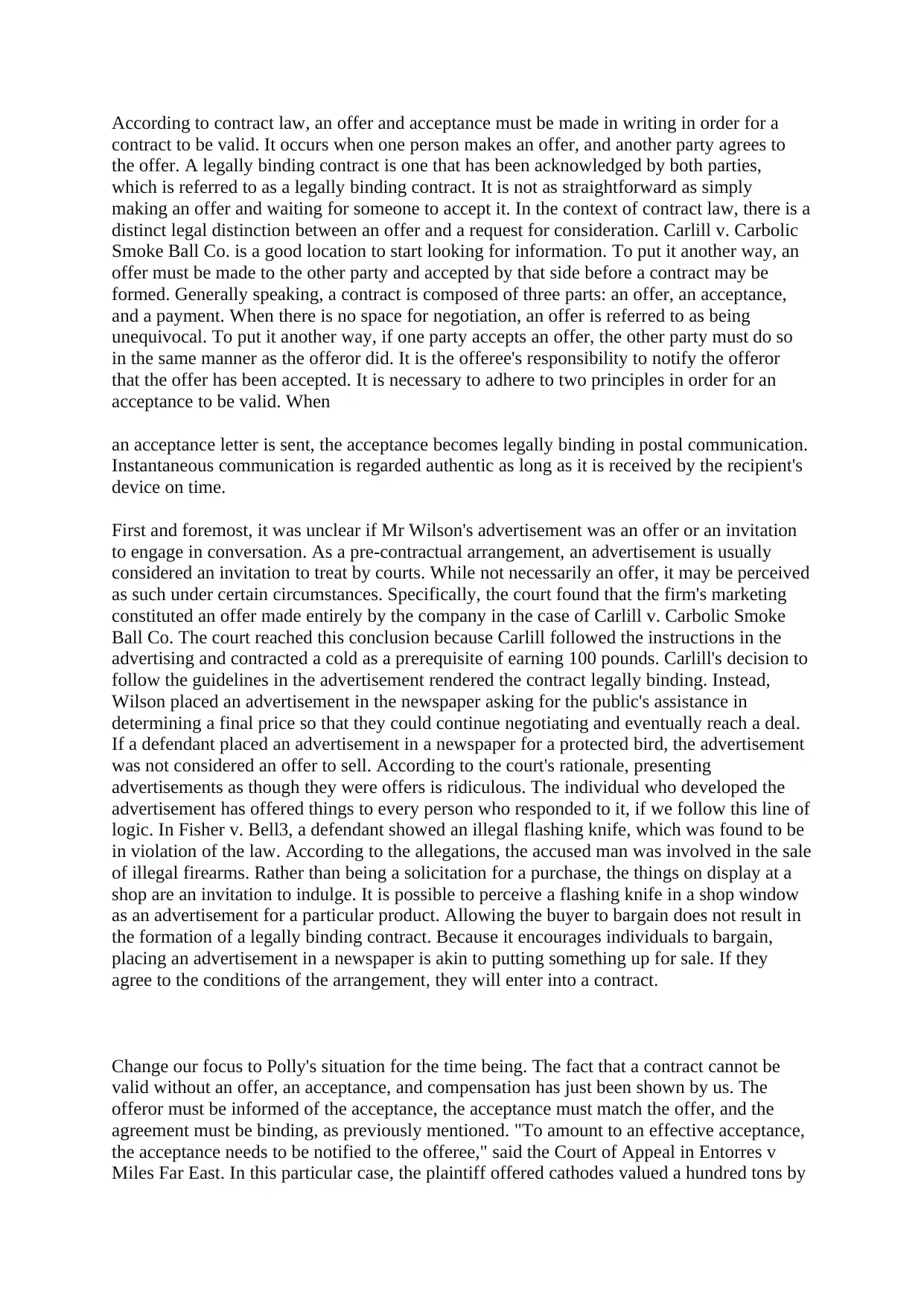
According to contract law, an offer and acceptance must be made in writing in order for a
contract to be valid. It occurs when one person makes an offer, and another party agrees to
the offer. A legally binding contract is one that has been acknowledged by both parties,
which is referred to as a legally binding contract. It is not as straightforward as simply
making an offer and waiting for someone to accept it. In the context of contract law, there is a
distinct legal distinction between an offer and a request for consideration. Carlill v. Carbolic
Smoke Ball Co. is a good location to start looking for information. To put it another way, an
offer must be made to the other party and accepted by that side before a contract may be
formed. Generally speaking, a contract is composed of three parts: an offer, an acceptance,
and a payment. When there is no space for negotiation, an offer is referred to as being
unequivocal. To put it another way, if one party accepts an offer, the other party must do so
in the same manner as the offeror did. It is the offeree's responsibility to notify the offeror
that the offer has been accepted. It is necessary to adhere to two principles in order for an
acceptance to be valid. When
an acceptance letter is sent, the acceptance becomes legally binding in postal communication.
Instantaneous communication is regarded authentic as long as it is received by the recipient's
device on time.
First and foremost, it was unclear if Mr Wilson's advertisement was an offer or an invitation
to engage in conversation. As a pre-contractual arrangement, an advertisement is usually
considered an invitation to treat by courts. While not necessarily an offer, it may be perceived
as such under certain circumstances. Specifically, the court found that the firm's marketing
constituted an offer made entirely by the company in the case of Carlill v. Carbolic Smoke
Ball Co. The court reached this conclusion because Carlill followed the instructions in the
advertising and contracted a cold as a prerequisite of earning 100 pounds. Carlill's decision to
follow the guidelines in the advertisement rendered the contract legally binding. Instead,
Wilson placed an advertisement in the newspaper asking for the public's assistance in
determining a final price so that they could continue negotiating and eventually reach a deal.
If a defendant placed an advertisement in a newspaper for a protected bird, the advertisement
was not considered an offer to sell. According to the court's rationale, presenting
advertisements as though they were offers is ridiculous. The individual who developed the
advertisement has offered things to every person who responded to it, if we follow this line of
logic. In Fisher v. Bell3, a defendant showed an illegal flashing knife, which was found to be
in violation of the law. According to the allegations, the accused man was involved in the sale
of illegal firearms. Rather than being a solicitation for a purchase, the things on display at a
shop are an invitation to indulge. It is possible to perceive a flashing knife in a shop window
as an advertisement for a particular product. Allowing the buyer to bargain does not result in
the formation of a legally binding contract. Because it encourages individuals to bargain,
placing an advertisement in a newspaper is akin to putting something up for sale. If they
agree to the conditions of the arrangement, they will enter into a contract.
Change our focus to Polly's situation for the time being. The fact that a contract cannot be
valid without an offer, an acceptance, and compensation has just been shown by us. The
offeror must be informed of the acceptance, the acceptance must match the offer, and the
agreement must be binding, as previously mentioned. "To amount to an effective acceptance,
the acceptance needs to be notified to the offeree," said the Court of Appeal in Entorres v
Miles Far East. In this particular case, the plaintiff offered cathodes valued a hundred tons by
contract to be valid. It occurs when one person makes an offer, and another party agrees to
the offer. A legally binding contract is one that has been acknowledged by both parties,
which is referred to as a legally binding contract. It is not as straightforward as simply
making an offer and waiting for someone to accept it. In the context of contract law, there is a
distinct legal distinction between an offer and a request for consideration. Carlill v. Carbolic
Smoke Ball Co. is a good location to start looking for information. To put it another way, an
offer must be made to the other party and accepted by that side before a contract may be
formed. Generally speaking, a contract is composed of three parts: an offer, an acceptance,
and a payment. When there is no space for negotiation, an offer is referred to as being
unequivocal. To put it another way, if one party accepts an offer, the other party must do so
in the same manner as the offeror did. It is the offeree's responsibility to notify the offeror
that the offer has been accepted. It is necessary to adhere to two principles in order for an
acceptance to be valid. When
an acceptance letter is sent, the acceptance becomes legally binding in postal communication.
Instantaneous communication is regarded authentic as long as it is received by the recipient's
device on time.
First and foremost, it was unclear if Mr Wilson's advertisement was an offer or an invitation
to engage in conversation. As a pre-contractual arrangement, an advertisement is usually
considered an invitation to treat by courts. While not necessarily an offer, it may be perceived
as such under certain circumstances. Specifically, the court found that the firm's marketing
constituted an offer made entirely by the company in the case of Carlill v. Carbolic Smoke
Ball Co. The court reached this conclusion because Carlill followed the instructions in the
advertising and contracted a cold as a prerequisite of earning 100 pounds. Carlill's decision to
follow the guidelines in the advertisement rendered the contract legally binding. Instead,
Wilson placed an advertisement in the newspaper asking for the public's assistance in
determining a final price so that they could continue negotiating and eventually reach a deal.
If a defendant placed an advertisement in a newspaper for a protected bird, the advertisement
was not considered an offer to sell. According to the court's rationale, presenting
advertisements as though they were offers is ridiculous. The individual who developed the
advertisement has offered things to every person who responded to it, if we follow this line of
logic. In Fisher v. Bell3, a defendant showed an illegal flashing knife, which was found to be
in violation of the law. According to the allegations, the accused man was involved in the sale
of illegal firearms. Rather than being a solicitation for a purchase, the things on display at a
shop are an invitation to indulge. It is possible to perceive a flashing knife in a shop window
as an advertisement for a particular product. Allowing the buyer to bargain does not result in
the formation of a legally binding contract. Because it encourages individuals to bargain,
placing an advertisement in a newspaper is akin to putting something up for sale. If they
agree to the conditions of the arrangement, they will enter into a contract.
Change our focus to Polly's situation for the time being. The fact that a contract cannot be
valid without an offer, an acceptance, and compensation has just been shown by us. The
offeror must be informed of the acceptance, the acceptance must match the offer, and the
agreement must be binding, as previously mentioned. "To amount to an effective acceptance,
the acceptance needs to be notified to the offeree," said the Court of Appeal in Entorres v
Miles Far East. In this particular case, the plaintiff offered cathodes valued a hundred tons by
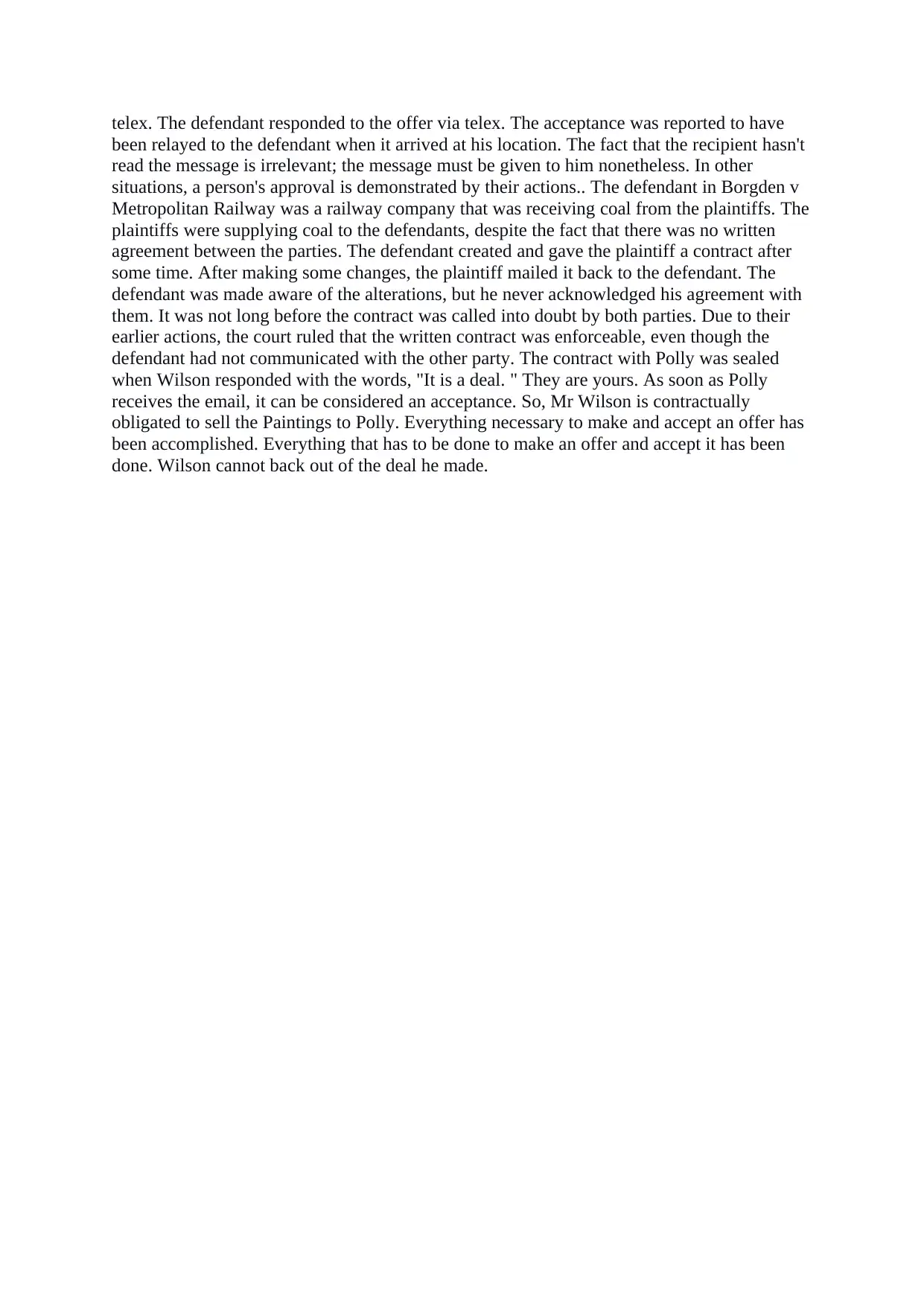
telex. The defendant responded to the offer via telex. The acceptance was reported to have
been relayed to the defendant when it arrived at his location. The fact that the recipient hasn't
read the message is irrelevant; the message must be given to him nonetheless. In other
situations, a person's approval is demonstrated by their actions.. The defendant in Borgden v
Metropolitan Railway was a railway company that was receiving coal from the plaintiffs. The
plaintiffs were supplying coal to the defendants, despite the fact that there was no written
agreement between the parties. The defendant created and gave the plaintiff a contract after
some time. After making some changes, the plaintiff mailed it back to the defendant. The
defendant was made aware of the alterations, but he never acknowledged his agreement with
them. It was not long before the contract was called into doubt by both parties. Due to their
earlier actions, the court ruled that the written contract was enforceable, even though the
defendant had not communicated with the other party. The contract with Polly was sealed
when Wilson responded with the words, "It is a deal. " They are yours. As soon as Polly
receives the email, it can be considered an acceptance. So, Mr Wilson is contractually
obligated to sell the Paintings to Polly. Everything necessary to make and accept an offer has
been accomplished. Everything that has to be done to make an offer and accept it has been
done. Wilson cannot back out of the deal he made.
been relayed to the defendant when it arrived at his location. The fact that the recipient hasn't
read the message is irrelevant; the message must be given to him nonetheless. In other
situations, a person's approval is demonstrated by their actions.. The defendant in Borgden v
Metropolitan Railway was a railway company that was receiving coal from the plaintiffs. The
plaintiffs were supplying coal to the defendants, despite the fact that there was no written
agreement between the parties. The defendant created and gave the plaintiff a contract after
some time. After making some changes, the plaintiff mailed it back to the defendant. The
defendant was made aware of the alterations, but he never acknowledged his agreement with
them. It was not long before the contract was called into doubt by both parties. Due to their
earlier actions, the court ruled that the written contract was enforceable, even though the
defendant had not communicated with the other party. The contract with Polly was sealed
when Wilson responded with the words, "It is a deal. " They are yours. As soon as Polly
receives the email, it can be considered an acceptance. So, Mr Wilson is contractually
obligated to sell the Paintings to Polly. Everything necessary to make and accept an offer has
been accomplished. Everything that has to be done to make an offer and accept it has been
done. Wilson cannot back out of the deal he made.
⊘ This is a preview!⊘
Do you want full access?
Subscribe today to unlock all pages.

Trusted by 1+ million students worldwide
1 out of 12
Related Documents
Your All-in-One AI-Powered Toolkit for Academic Success.
+13062052269
info@desklib.com
Available 24*7 on WhatsApp / Email
![[object Object]](/_next/static/media/star-bottom.7253800d.svg)
Unlock your academic potential
Copyright © 2020–2025 A2Z Services. All Rights Reserved. Developed and managed by ZUCOL.





